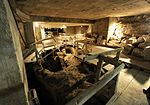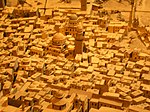Yeshivat HaKotel

Yeshivat HaKotel (Hebrew: ישיבת הכותל, lit. 'Yeshiva of the Western Wall') is a religious Zionist Hesder yeshiva in the Old City of Jerusalem, opposite the Temple Mount and overlooking the Kotel (Western Wall), hence its name. Most of the students are in the Israeli Hesder program which combines at least fifteen months of army service with several years of Yeshiva study.Baruch Wieder, the former Rosh Kollel, is the Rosh Yeshiva. The previous Rosh Yeshiva was Yeshayahu Hadari who served as Rosh Yeshiva for more than thirty years, although not consecutively. Mordechai Elon was Rosh Yeshiva from 2002–2006. Yeshivat HaKotel has a program for English-speaking students that offers integration with Israelis, a broad comprehensive curriculum in Talmud, Tanakh, Machshava, Halacha, and Mussar. In 2006, Yeshivat HaKotel opened a new program for Portuguese and Spanish-speaking students, headed by Brazilian-born rabbi Daniel Segal. As of 2011, more than 100 students from Latin American countries, including Brazil, Argentina, Uruguay, Mexico, Panama, Peru and Colombia, and also from Portugal and Spain, have graduated this program.
Excerpt from the Wikipedia article Yeshivat HaKotel (License: CC BY-SA 3.0, Authors, Images).Yeshivat HaKotel
Heil HaHandasa, Jerusalem Morasha
Geographical coordinates (GPS) Address Nearby Places Show on map
Geographical coordinates (GPS)
| Latitude | Longitude |
|---|---|
| N 31.7752469 ° | E 35.2326693 ° |
Address
העיר העתיקה בירושלים וחומותיה
Heil HaHandasa
9511208 Jerusalem, Morasha
Jerusalem District, Israel
Open on Google Maps








